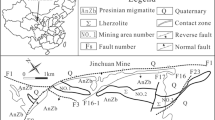Abstract
A three-dimensional photoelastic-model study of two horizontal mining excavations with a central pillar is described. Details of experimental techniques used are given and stress distributions, rock-fracture initiation zones and the directions of subsequent fracture propagation around these excavations are determined. It is shown that the techniques adopted for this investigation offer realistic means for comparative design studies of best shape and layout of mining excavations.
Similar content being viewed by others
Abbreviations
- σ1:
-
major principal component of the applied stress
- σ3:
-
minor principal component of the applied stress
- k :
-
σ3/σ1
- σt :
-
uniaxial tensile strength of the material
- ψt :
-
critical crack orientation
- μ:
-
coefficient of internal friction between crack faces
- V :
-
voltage
- p :
-
mean vertical nominal stress
- S :
-
stope width
- P :
-
pillar width
References
Ryder, J. A. and Officer, N. C., “An Elastic Analysis of Strata Movement Observed in the Vicinity of Inclined Excavation,” Symposium on Rock Mechanics and Strata Control in Mines, South African Institute of Mining and Metallurgy, Johannesburg (1965), pp. 168–193.
Bieniawski, Z. T., “Mechanism of Brittle Fracture of Rock, Part I, II and III,”Intl. Jnl. Rock Mech. and Mining Sci.,4 (4),395–430 (October1967).
Hoek, E. andBieniawski, Z. T., “Brittle Fracture Propagation in Rock under Compression,”Intl. Jnl. Fracture Mech.,1 (3),137–155 (September 1965).
Griffith, A. A., “Theory of Rupture,” Intl. Congr. Appl. Mech., ed. Biezeno and Burgers, J. Waltman, Jr., Press, Delft, 55–63 (1925).
McClintock, F. A., and Walsh, J. B., “Friction on Griffith Cracks in Rock under Pressure,” Proc. Fourth U. S. Congr. Appl. Mech., Am. Soc. Mech. Engrs., New York, 1015–1021 (1963).
Leven, M. M., “Epoxy Resins for Photoelastic Use,”Photoelasticity, ed., Frocht, Pergamon Press, New York, 145–165 (1963).
Hoek, E., andBieniawski, Z. T., “Application of the Photoelastic Coating Technique to Study of Stress Redistribution Associated with Plastic Flow around Notches, Jnl. S. Afr. Inst. Mech. Engrs.,12 (9),275–287 (June 1963).
Hoek, E., “A Photoelastic Technique for Determination of Potential Fracture Zones in Rock Structures,”Failure and Breakage of Rock, ed. C. Fairhurst, Am. Inst. Min. Metall. Petr. Engrs., New York, 94–112 (1967).
Author information
Authors and Affiliations
Additional information
C. P. G. Van Tonder was Research Officer in the Division at the time when this study was conducted.
Rights and permissions
About this article
Cite this article
Bieniawski, Z.T., Van Tonder, C.P.G. A photoelastic-model study of stress distribution and rock fracture around mining excavations. Experimental Mechanics 9, 75–81 (1969). https://doi.org/10.1007/BF02326677
Issue Date:
DOI: https://doi.org/10.1007/BF02326677




